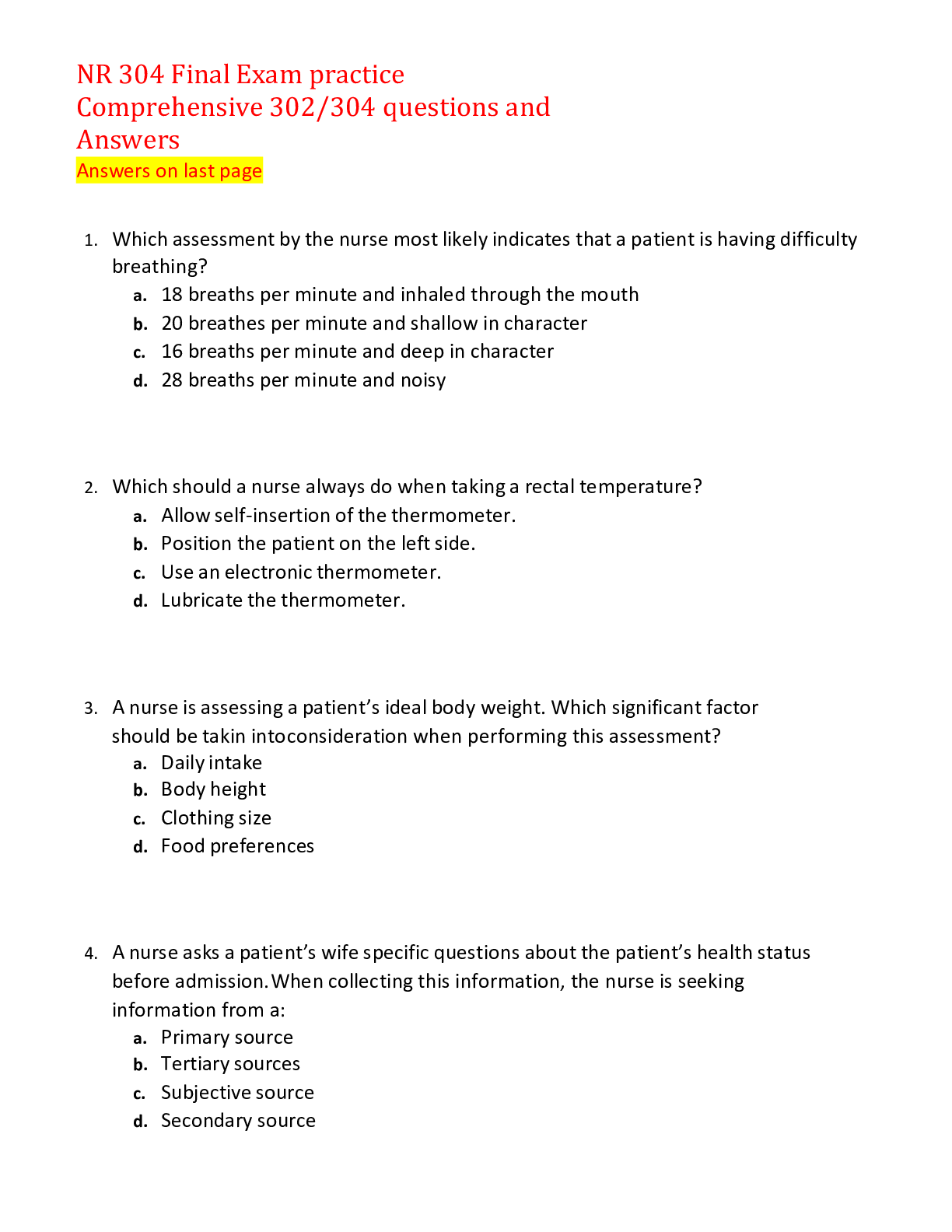*NURSING > QUESTIONS & ANSWERS > NBRC EXAM, Part I. All Questions with 100% Accurate answers. Graded A+ (All)
NBRC EXAM, Part I. All Questions with 100% Accurate answers. Graded A+
Document Content and Description Below
PATIENT ASSESSMENT: All the following could cause capnography to go from 3 6 to 30 EXCEPT: A. Endotracheal tube positioned in the right mainstream bronchus B. Hyperventilation C. pulmonary emboli ... D. Hypovolemia - ☑☑Endotracheal tube positioned in right mainstem bronchus is a problem but the co2 reading would not change, so ANSWER is A. What is the target Vt for individual on mechanical ventilation - ☑☑6-8 ml/kg (of ideal body weight) This is new strategy as of January 2015 Is the following Static OR Dynamic Compliance: Means flow throughout the respiratory system has stopped and all ventilatory muscle activity is absent. _______ conditions can be imposed with an inspiratory pause when a patient is sedated and mechanically ventilated. - ☑☑Static Compliance Is the following Static OR Dynamic Compliance: Flow at airway opening is zero. Mechanics are evaluated under ______ conditions, when non-intubated patient breathes spontaneously. - ☑☑Dynamic Compliance A balloon tipped flow directed catheter is positioned in the pulmonary artery with the balloon deflated. Which of the following pressures will be measured by the proximal lumen: a. Cvp b. Pap c. Pwp d. Map - ☑☑ANSWER is A. Cvp = deflated/proximal lumen Pap = deflated/distal Pwp = inflated/wedged All of the following will affect the accuracy of a capnography EXCEPT a. Long sampling line b. Low sampling flow c. Condensation in the tubing d. Use of desiccant - ☑☑Gas will pass through and out of a long sampling line before reaching analyzer so, low sampling flow will not give you enough information for a good reading, and condensation as a rule is always a problem especially in analyzers. Dessicant removes moisture from the gas, which is a good thing, so ANSWER is D A 1000 g neonate (normal baby is 3000 g) is stable in nicu. Which of the following should the respiratory therapist use to monitor the neonates overall cardiopulmonary status. a. TcPCO2 and TcPO2 monitor b. Arterial blood gas analysis Q4 c. SpO2 monitor d. Capillary gas analysis Q8 - ☑☑Since the baby is stable, go less invasive, also go continuous monitoring (not 4 hour or 8 hour), Transcutaneous (Tc) continuous monitoring of CO2 and O2 is the best. Answer is A A unilateral wheeze would most likely indicate which of the following. a. Asthma b. Atelectasis c. Foreign body aspiration d. Epiglottitis - ☑☑You wouldn't have asthma on just one side (unilateral), atelectasis would cause diminished breath sounds, with epiglottitis you would get stridor, since you are only hearing wheezing on one side, you are hearing it on the side where you aspirated something, so ANSWER is C All of the following would be associated with the presence of a pneumothorax EXCEPT a. Tracheal deviation b. Dull percussion c. Absent breath sounds d. Respiratory distress - ☑☑With pneumothorax you would hear a high pitch hyperresonnance, breath sounds would be absent, and respiratory distress could be present. Dull percussion would NOT be present, so ANSWER is B. What should you recommend FIRST for a patient with multifocal pvc's a. Administration of lidocaine b. Administration of 100% oxygen c. Administration of atropine d. Administration of epinephrine - ☑☑Multiple pvc's coming from multiple locations (multifocal) is a real problem and you should administer oxygen FIRST, so ANSWER is B. lidocaine will help reduce irritability of heart and help with pvc's but would not be first option, atropine is used for bradycardia and cardiac irregularities but not pvc's, epinephrine is emergency drug not for pvc's but more for pulseless ventricular tachycardia or ventricular fibrilation where heart is not responding . What is the normal range for the mean pulmonary artery pressure in an adult a. 2-6 mm Hg b. 4-12 mmHg c. 9-18 mmHg d. 21-28 mmHg - ☑☑Mean pulmonary artery pressure in an adult should be in the teens so best ANSWER is C A patient in the emergency dept has frothy secretions, moist crackles, and tachypnea. The patient has marked dyspnea and a history of heart disease. Which of the following should the respiratory therapist recommend. 1.suction immediately 2.administer 100% oxygen 3.place in Fowlers position 4.administer furosemide - ☑☑This is an emergency, they are having heart problems, dyspnea, frothy secretions indicating severe pulmonary edema, etc. so 100% oxygen immediately, having the patient in the Fowlers position (an upright position) will help pull fluid down away from the lungs, furosemide is a lasix (loop diuretic) which gets rid of excess fluid. You do NOT suction someone with frothy secretions and heart problems, this just delays appropriate therapy. So ANSWER is 2,3,4 Fine crepitant crackles are most commonly associated with which of the following conditions. a. Bronchiectasis b. Congestive heart failure c. Pneumonia d. Croup - ☑☑Crackles are associated with fluid so a, b, and c would be good answers, but "fine crepitant" crackles indicates fluid entering alveoli (pulmonary edema) which is most often caused by heart failure so the best ANSWER is B. (with croup you would hear more of a stridor sound). A patient is found in full cardiopulmonary arrest. CPR is started and the patient is orally intubated with an EtCO2 monitor attached. Which of the following EtCO2 patterns would the respiratory therapist expect to observe on the monitor? a. Initially high, then falling b. Initially low, then rising c. Initially high, stays high d. Initially low, stays low - ☑☑Full cardiac arrest will cause the CO2 in the lungs to slowly dissipate out because no blood is flowing, then during CPR when you get blood flowing, the CO2 should slowly rise back up; so ANSWER is B If the blood pressure obtained from the arterial line is higher than the blood pressure obtained from a sphygmomanometer (cuff pressure). Based upon this information, the respiratory therapist should conclude that. a. Non-compliant tubing is being used b. Transducer is placed too low c. Patient was lying flat during the measurement of the arterial line pressure d. Transducer dome contained air bubbles - ☑☑Arterial line BP and cuff pressure should be the same, so there is a problem. Non-compliant tubing is a good thing because it's a stiff tubing, if transducer is placed too high (above the heart), the flood will have to go uphill and you will get a lower pressure; transducer dome contained air bubbles would give you erratic readings but not a higher reading, but if the transducer is placed too low (below heart), the blood is flowing downhill & will give a higher pressure reading, so ANSWER is B A 2-year old child enters the emergency room. The mother states that the child was playing with friends and developed violent coughing and unilateral wheezing. Physical examination reveals a hyperresonant percussion note on the left and resonant percussion on the right. Inspiratory and expiratory chest films indicate air trapping with no foreign bodies "noted." The respiratory therapist should suspect the child has. a.pneumothorax b.orthopnea c.aspirated a foreign object d.tachyphylaxis - ☑☑Unilateral wheezing indicates aspirated object and fact that the child was playing with friends causes you to believe the child inhaled a small toy or something, hyperresonant percussion indicates air trapping, so you are thinking foreign object but x-ray says no foreign bodies "noted." Just because it says "noted" does not mean something is not there, it just means it could not be seen on the xray, also if the child had swallowed a small plastic toy, "plastic" does not show up on xrays (radiolucent). The ANSWER is C A patient is admitted to the ICU complaining of nausea and chest pain. A nasogastric tube has been inserted to help relieve the nausea. The patient was started on Lasix and nitroglycerin. Which of the following should be monitored to closely identify side effects at this time. a. Cardiac enzymes b. Serum electrolytes c. Arterial blood gases d. Digitalis levels - ☑☑Since the patient received Lasix and nasogastric tube, they are losing fluids, and a side effect of fluid loss is a decrease in electrolytes, so ANSWER is B (there isn't enough evidence of heart attack to justify cardiac enzymes, also they are used to confirm a heart attack). Which of the following will determine aortic pulse pressure. a. systolic + systolic + diastolic/3 b. diastolic + pulse pressure/3 c. systolic pressure - diastolic pressure d. stroke volume x heart rate x 10. - ☑☑Aortic pulse pressure is just the difference between systolic and diastolic pressure, so ANSWER is C A 32-week gestational age infant is receiving mechanical ventilation for hyaline membrane disease. The patient required a chest tube for a persistent pneumothorax. Two days later the chest radiograph reveals bilateral radiolucency, midline mediastinum, and the right hemidiaphragm slightly elevated. This would indicate A. atelectasis. B. bronchopulmonary dysplasia. C. fluid overload. D. resolution of a pneumothorax. - ☑☑bilateral means both sides, radiolucency refers to dark, midline mediastinum is right where is should be, the right hemidiaphragm slightly elevated is normal; so this actually indicates everything is normal. With atelectasis we would see patchy infiltrates, loss of volume, with bronchopulmonary dysplasia it would look similar to ARDS, with fluid overload you would see pattern similar to butterfly or batwing similar to pulmonary edema, so the best ANSWER is D and the pneumothorax has resolved. A chest X-ray shows increased retro-sternal air, flat hemidiaphram, decreased movement, and no vascular markings on the right side. These signs would be most likely associated with: A. pneumothorax B. pleural effusion C. pneumonia D. flail chest - ☑☑The flat hemidiaphram indicates pneumothorax, so the ANSWER is A. What is the normal range for the pulmonary artery systolic pressure in an adult? A. 2-6 mm Hg B. 4-12 mm Hg C. 9-18 mm Hg D. 21-28 mm Hg - ☑☑The normal pressure is 25 mm Hg, so the ANSWER is D 21-28 mm Hg While assessing a patient's breath sounds the respiratory therapist notes that when the patient is instructed to say the letter "E", it comes through the stethescope sounding like "aaaahhh". This change in the sound is associated with which of the following conditions? A. Pleuritic inflammation B. Pneumonia C. Bronchospasm D. Epiglotitis - ☑☑The sound aaaaahhhhh is egotheny and is associated with consolidation in the lung, so the ANSWER is B pneumonia. Pleural inflammation would be a crackling crunching sound, bronchospasm would sound like wheezing, and epiglottitis would be stridor. An 1800 g neonate in the NICU is being monitored with a TcPO2 electrode. The TcPO2 electrode is reading 42 torr with the temperature set at 38oC. The PO2 from an umbilical artery sample is 72 torr. Which of the following would best explain the difference in these readings? A. There was an error in the arterial blood gas results. B. The TcPO2 electrode needs to be repositioned. C. The TcPO2 electrode temperature setting is too low. D. The TcPO2 electrode has been dislodged. - ☑☑TcPO2 should be set at 43-45 C so the electrode is not hot enough to make the device work. There is not enough profusion with the electrode so you need to raise the temperature on the electrode, so the ANSWER is C, TcPO2 electrode temperature setting is too low. A multiple trauma victim with internal hemorrhage is being monitored via pulse oximetry. Which of the following conditions would affect the accuracy of her SpO2 readings? A. hypotension B. hyperoxia C. hypocarbia D. hyperthermia - ☑☑Since the SpO2 measures the color of the blood and the ability to shine a light through the blood, the only answer that would affect the accuracy of the SpO2 reading would be ANSWER A hypotension because hypotension causes less profusion (needed for the SpO2 reading) A patient with COPD has been admitted for possible pneumonia. The patient is producing moderate amounts of thick yellow sputum and breath sounds are decreased in the right middle lobe. Sputum culture indicates a staphylococcal infection. Which of the following therapies should the respiratory therapist recommend? A. chest physical therapy B. antibiotic therapy C. incentive spirometry D. IPPB - ☑☑The priority in this case is the infection and only the antibiotic treatment can get rid of the infection, so the ANSWER is B, Antibiotic treatment. A premature baby is receiving an FIO2 of .40 and CPAP at 5 cmH2O. As the respiratory therapist increases the CPAP to 7 cmH2O, the baby's respiratory rate increases to 58 per minute and the TcPCO2 reading increases with a stable SpO2 monitor reading. The respiratory therapist should recommend which of the following? A. Discontinue the CPAP B. Draw an arterial blood gas sample C. Increase the CPAP to 10 cmH2O D. Place the baby in an oxyhood at an FIO2 0.45 - ☑☑Drawing an ABG would give us more information and since this is not an emergency that is the best ANSWER B, arterial blood gas. A 44-year-old woman has just undergone a cholecystectomy. Over the last 48 hours the patient has the following laboratory findings: K+: 3 mEq/L Na+: 115 mEq/L Cl-: 80 mEq/L HCO3-: 24 mEq/L Urine output: 60 mL/hour BP: 125/95 mm Hg Based upon this information the respiratory therapist would conclude A. the patient is hyperkalemic B. the patient requires decreased fluid intake C. the patient is polycythemic D. the patient has a metabolic alkalosis - ☑☑Hyperkalemic is high potassium, polycythemic has extra red blood cells, and we do not have Hb measurement, metabolic alkalosis is associated with low potassium but the bicarb is normal (and it would be high with low potassium), the urine output is high so the best ANSWER is B, patient requires reduced fluid intake. A 55-year-old patient is admitted to CCU with chest pain. While assembling an oxygen mask, the respiratory therapist notes the following ECG pattern: Ventricular fibrillation The patient is now unconscious, unresponsive and has no palpable pulse. The therapist's first response should be to: A. administer oxygen by non-rebreather mask. B. deliver a pre-cordial thump. C. recommend intravenous amiodarone. D. perform synchronized cardioversion. - ☑☑Since you are actually witnessing a ventricular fibrillation, the very first thing you can do is try to get their heart started again by doing ANSWER B, deliver a pre-cordial thump which is a good thump right in the center of their sternum. The respiratory therapist notices a dampened waveform on a pulmonary arterial line. The therapist's first action should be to A. attempt to draw blood from the line. B. check the transducer dome for air bubbles. C. flush the catheter with heparin solution. D. check the position of the transducer. - ☑☑Dampened wave form is when you aren't getting a nice sharp reading, you should get a clear systolic and diastolic pattern; the most common cause is a blood clot, flushing the catheter with heparin might push the blood clot into the lung at this point (not a good idea), another common cause of a dampened wave form is air bubbles in the transducer dome, so the ANSWER is B. A patient in the intensive care unit is suffering left heart failure. Which of the following drugs will increase the strength of contraction and improve cardiac output? A. digitalis B. atropine C. isuprel D. lidocaine - ☑☑Atropine is used for bradycardia and increases output but not strength, Isuprel treats bradycardia and output but not strength, Lidocaine reduces irritability of heart, but Digitalis is a cardiac glycoside that increases cardiac output and strengthens cardiac contraction, so ANSWER is A The results of a patient's chest radiograph reveal the presence of a left basilar free fluid accumulation with a meniscus formation. Physical examination of the chest indicates a dull percussion note on the left and trachea shifted to the right. These results are consistent with which of the following conditions? A. Pleural effusion on the left B. Basilar pneumonia of the left lung C. Atelectasis of the left lung D. Pneumothorax in the left lung - ☑☑Miniscus formation means accumulation is curling and going up the side, dull percussion can be solid or fluid filled (not just consolidation), since its pushing to the right it has to be a problem outside the lung, so the ANSWER is A. The respiratory therapist has been paged to the ICU to assist in the treatment of a 98 kg (215 lb) man. The patient is pale, diaphoretic, and suddenly loses consciousness. No palpable pulse or blood pressure is measured. The ECG monitor displays the following sinus bradycardia with a rate of 45): The respiratory therapist should: A. confirm the ECG in another lead. B. begin chest compressions. C. perform cardioversion. D. perform defibrillation. - ☑☑ECG is showing sinus bradycardia with a rate of 45, all this leads up to begin chest compressions, so ANSWER is B. Do not perform cardioversion or defribulation because there is no arrhythmia so we don't want to mess with anything electrical in the heart, just want to help it out mechanically. The respiratory therapist is assessing a patient's vital signs and notes that the pulse feels weak and thready. This would most likely be associated with which of the following conditions? A. Hypervolemia B. Shock C. Increased cardiac output D. Increased systemic vascular resistance - ☑☑A weak and thread pulse can be associated with conditions that decrease the blood pressure like shock or hypovalemia, so the ANSWER is B shock. A patient who recently underwent a total abdominal hysterectomy is complaining of chills and purulent sputum. Breath sounds reveal coarse rales and rhonchi. The results of the CBC indicate a WBC count of 19,000. The most likely diagnosis is that the patient has developed: A. atelectasis B. pneumonia C. hemothorax D. bacterial infection - ☑☑Bacterial infections cause purulent sputum which is increased WBC's; viral infections do not. It might be pneumonia, but we do not know without more information, so the best answer is D bacterial infection, After injecting a small amount of air into the balloon of a pulmonary artery catheter, the respiratory therapist sees a small amplitude change with the mean pressure reading 2 points below the PA end-diastolic pressure. Based upon this information, the therapist should conclude that A. there is pressure dampening. B. the transducer is placed too high. C. there is an obstruction in the catheter. D. this is a normal wedge tracing. - ☑☑A small amplitude change is normal and the mean pressure reading 2 points below the pulmonary artery end-diastolic pressure is also normal, so the ANSWER is D. A 32-week gestational age infant is receiving mechanical ventilation for hyaline membrane disease. The respiratory therapist suspects that a pneumothorax has developed and performs transillumination, which reveals a brightly illuminated left thorax. The respiratory therapist's FIRST action should be to A. insert a chest tube and connect to a pleural suction system. B. perform a fiberoptic bronchoscopy. C. obtain a STAT chest film. D. suction the infant. - ☑☑Since a pneumothorax was suspected, illumination was done and revealed a "brightly illuminated left thorax" (a halo effect would be normal). A brightly illuminated thorax indicates there is definitely too much air or a pneumothorax in the left lung. Whenever there is a pneumothorax, you don't need more information, you need to insert a chest tube and connect to a pleural suction system, so the ANSWER is A. A patient with a history of myasthenia gravis has just been admitted for increased muscle weakness. The respiratory therapist should recommend which of the following diagnostic tests to monitor the patient's drug therapy? A. polysomnography B. electroencephalography C. tensilon challenge test D. methacholine challenge test - ☑☑Polysomnography is a sleep study, Electroencephalography is an EEG brain test, Methacholine Challenge Test is a pulmonary function test used to check the reactivity of a patients airways, it will induce bronchospasm; Tensilon Challenge Test is specifically for Myasthenia Gravis, it helps them breath right away but only lasts a few minutes, so the ANSWER is D. While assessing a patient's breath sounds the respiratory therapist notes that when the patient says "ninety-nine", it sounds very loud through the stethescope. This would be associated with which of the following conditions? A. Pneumothorax B. Pneumonia C. Pleural effusion D. Epiglottitis - ☑☑99 is a sound that produces vibrations in the lung, if 99 sounds very loud through the stethoscope you know consolidation is present, so the ANSWER is B. Pleural effusion you don't usually hear anything. A 47-year-old patient admitted for sepsis has a CaO2 value of 12.5 vol%. The patient does not appear cyanotic. Which of the following would be the most important to further evaluate the patient's oxygenation status? A. PaO2 B. SaO2 [Show More]
Last updated: 2 years ago
Preview 1 out of 42 pages
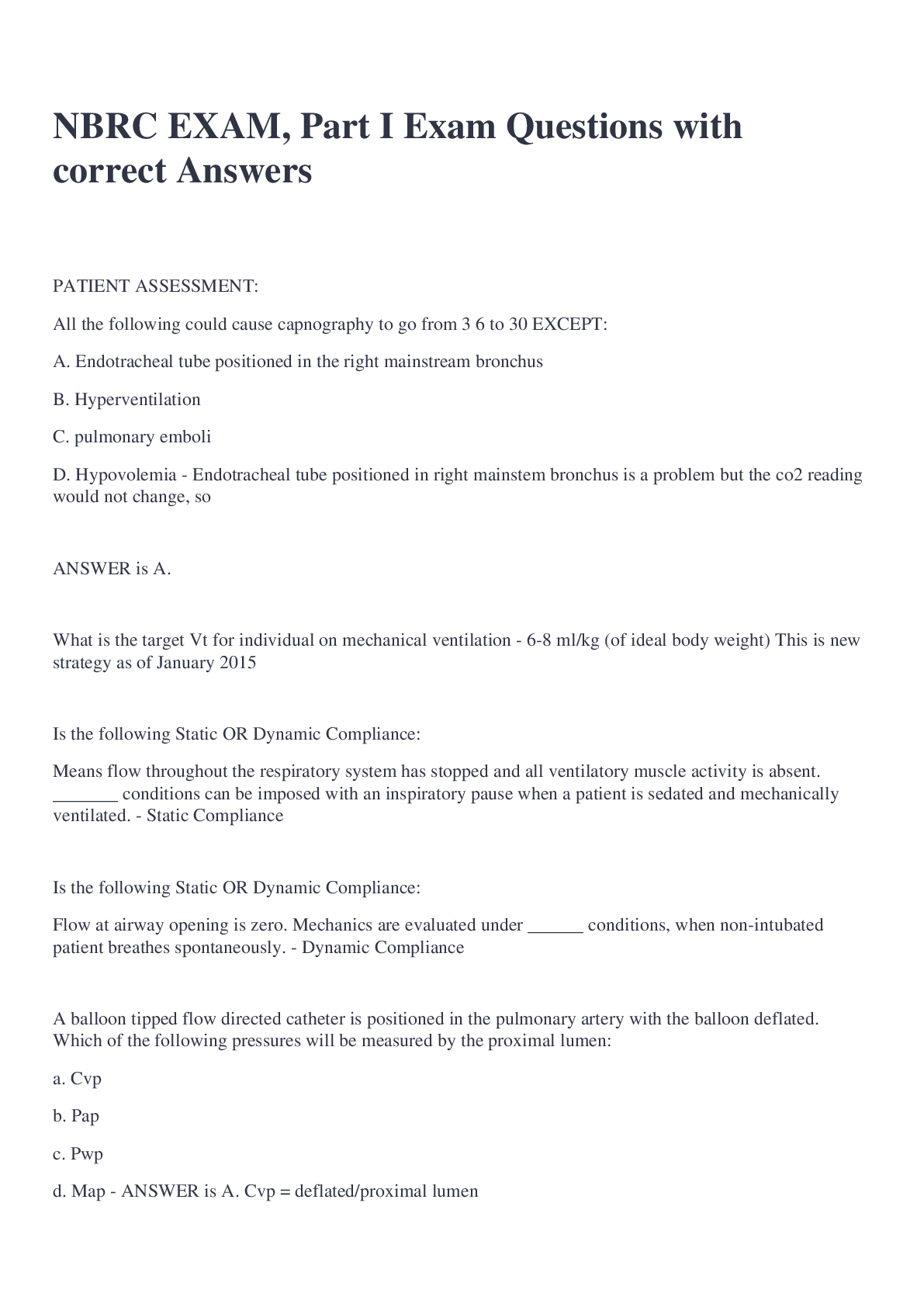
Buy this document to get the full access instantly
Instant Download Access after purchase
Buy NowInstant download
We Accept:

Also available in bundle (2)

NBRC EXAM BUNDLE, QUESTIONS WITH ACCURATE ANSWERS, RATED A+
NBRC QUESTION WITH ACCURATE ANSWERS, EXAMINABLE QUESTIONS AND ANSWERS
By bundleHub Solution guider 2 years ago
$28
6

All Part 1 NBRC exam predictor documents. latest versions 2022. graded A+
NBRC EXAM, Part I. All Questions with 100% Accurate answers. Graded A+ NBRC EXAM Part 1 REDUCED, Questions and answers. Reviewed. Latest 2022. Rated A+
By bundleHub Solution guider 3 years ago
$16
2
Reviews( 0 )
$12.00
Can't find what you want? Try our AI powered Search
Document information
Connected school, study & course
About the document
Uploaded On
Aug 07, 2022
Number of pages
42
Written in
Seller

Reviews Received
Additional information
This document has been written for:
Uploaded
Aug 07, 2022
Downloads
0
Views
117












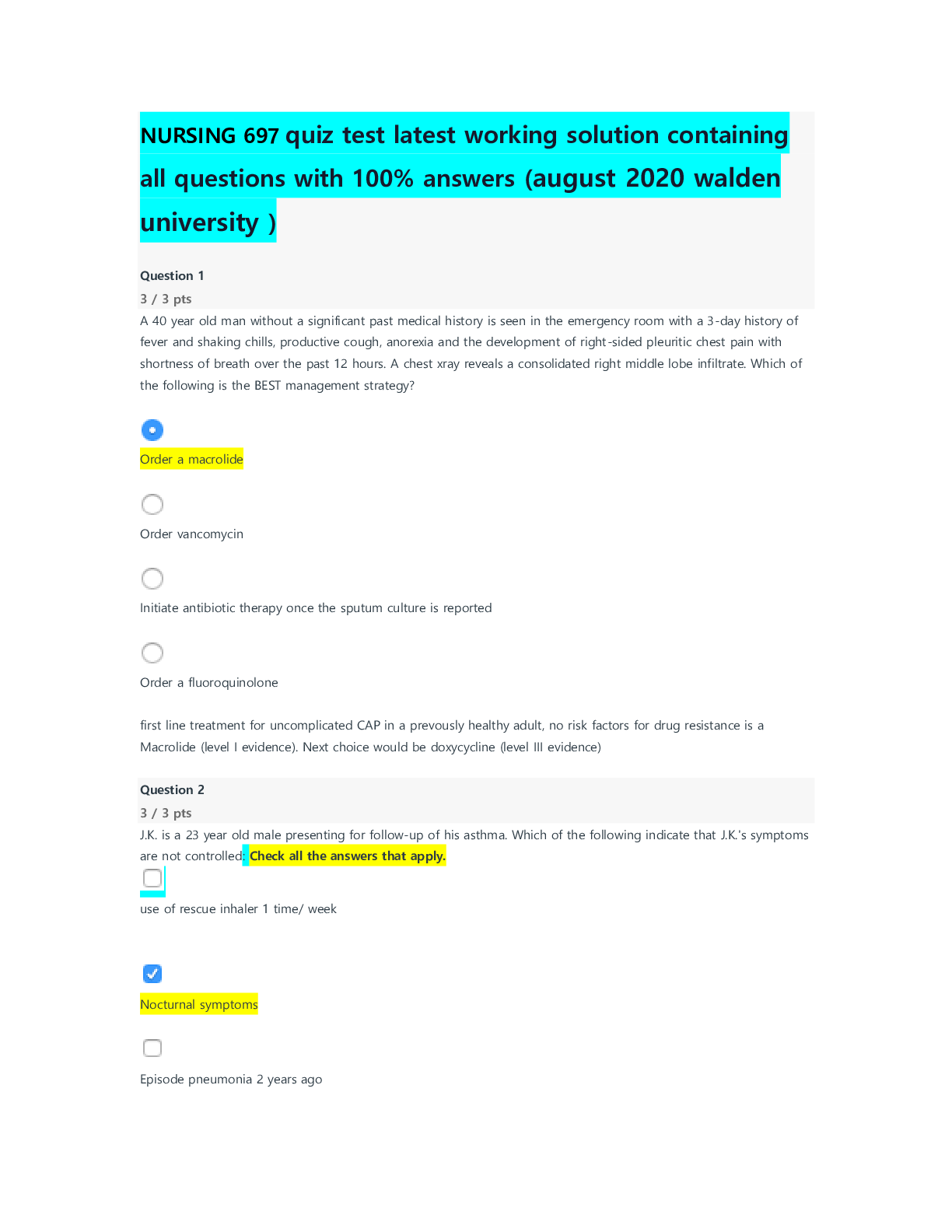


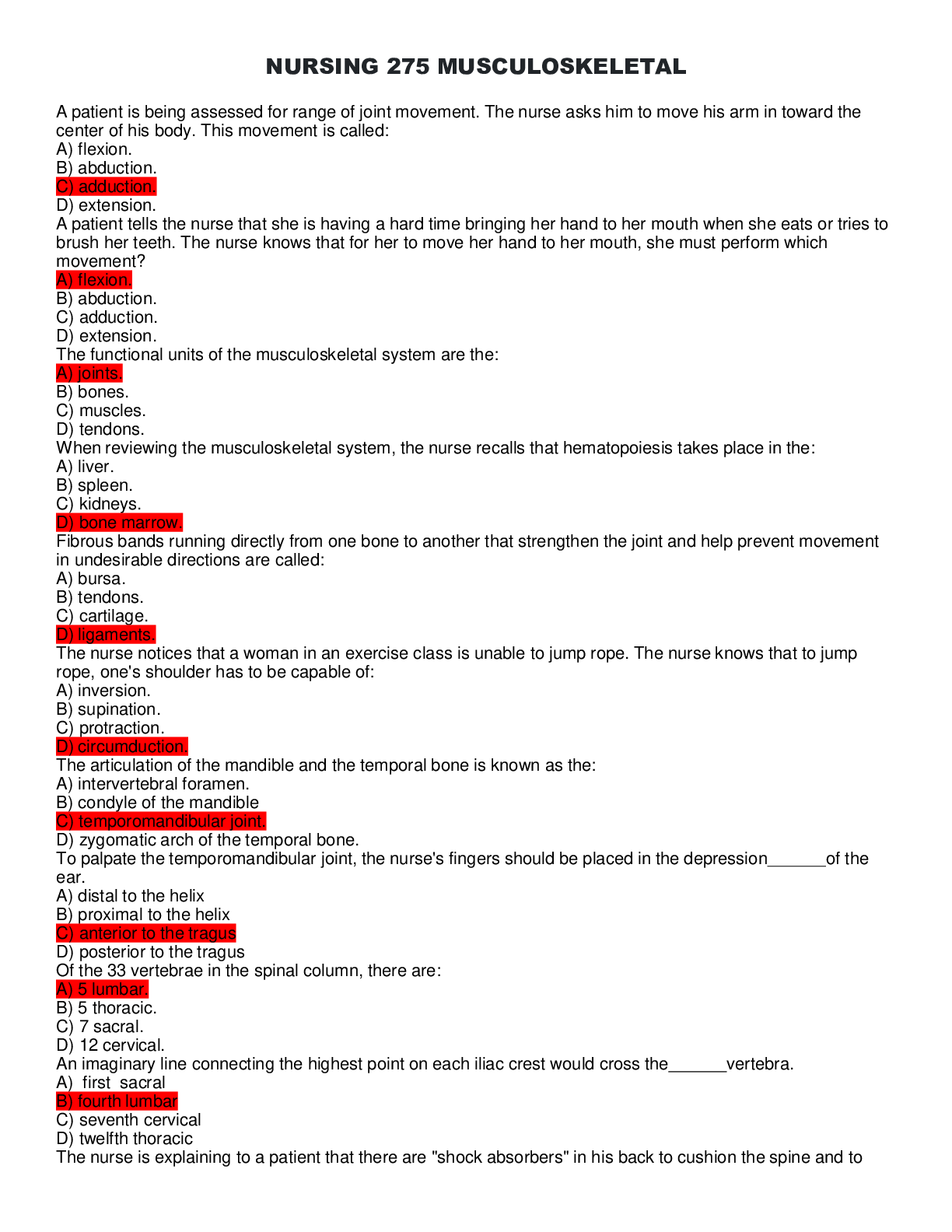




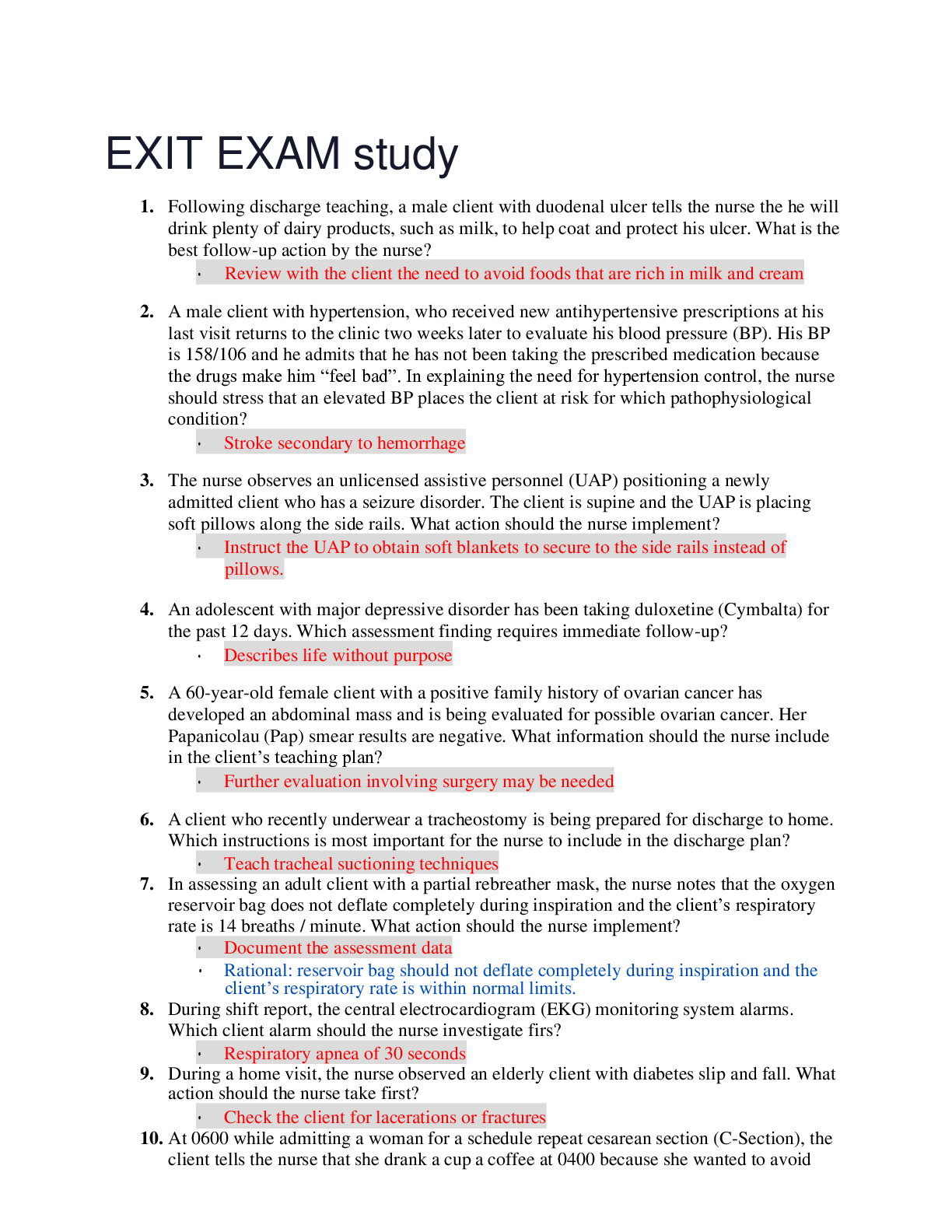
.png)
.png)
